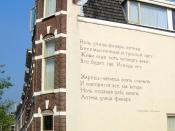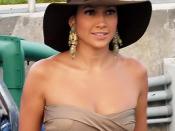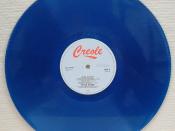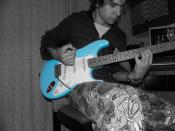The Man with the Blue Guitar The Man with the Blue Guitar is a long and very confusing poem at first glance. Not until after reading through it a second time did I find what I believe the poem means to me. It may have 100 different meanings to 100 different people, but I think that Stevens is making a point about art and society in this poem. The transitions shown by the man with the blue guitar and his audience shows the movement made between society and artists throughout time.
The audience listening to the man with the blue guitar, I believe is a representation of society. They are criticizing what the man with the blue guitar plays, which I believe is society's censorship of art altogether.
But play, you must, A tune beyond us, yet ourselves A tune upon the blue guitar, Of things exactly as they are.
Society tries to cripple the man's speech by telling him to keep his verse within reality. They expect the man's song, and all art within society, to touch them and move them, but not to radically change reality. Throughout the poem, the audience is becoming more lenient towards the man's song. At the beginning, they are very critical, however towards the end of the poem they begin to see the man's views, to praise art and the freedom it brings to people. "Nothing must stand/Between you and the shapes you takeâ¦" This is the audience apologizing to the man for trying to tell him what to sing. They are the blockades that stand between the man and the shapes he takes in his song. These shapes are freedom and liberty and everything creative that can transform in a person inside a work of art that they create. Literary censorship is the topic argued between the audience and the man with the blue guitar. The progress made by the audience throughout the poem is similar to progress made by society over time. Artistic works that are tolerated today would never be viewed as acceptable in the 1950s. This acceptance has been a growing transition throughout every generation in time, as one society becomes more accepting than the next. What would the generation that scoffed at Elvis' hip shaking in the 1950s think about the outfits worn by Jennifer Lopez and Britney Spears today? This is the progress that has been shown by society towards art, just like the progress that the audience made to the man's ideas of art in his song.
The man with the blue guitar also progresses throughout the poem. He starts off telling the audience what he sings of, and what he can do. "I sing a hero's head, large eye/And bearded bronze, but not a man. The man, in the beginning is telling the audience how he can show life with his guitar.
And all their manner, right and wrong, And all their manner, weak and strong? The feelings crazily, craftily call, Like a buzzing of flies in autumn air, And that's life, then: Things as they are This buzzing of the blue guitar.
He is trying to convince the audience that he has the right view of his music. He knows he can transform the audience with his music. He is showing the audience all that he can tell with his guitar. He can sing of a hero's conquest, of tragedy in the world. He can sing of the sun and the stars, and tragic stories of families. Midway through his explanation however, I think that he realizes how art has affected him. He no longer tells his stories to educate society. He does it to educate himself. "Not at the eye but at the joy of it. I play. But this is what I think." His songs are what he believes in, and what goes on in his head. In the end, the man comes together with the audience, agreeing on the importance of art in society.
We shall forget by day, except The moments when we choose to play The imagined pine, the imagined jay.
The progression that is seen in this poem is great. It is the movement of one group's opinion, from disagreeing with the man in the beginning, until the end when they talk as one. The poem is different throughout because different people are talking in different parts. In the early stages, it is easy to identify who is talking, however as it gets nearer to the end of the poem, it is more difficult because the ideas of the audience are changing. They are adapting to the ideas which the man with the blue guitar stressed in the beginning. The audience is realizing these ideas of freedom of artistic expression. In the beginning, the audience wanted no part of this. They believed that the man should be stricken to a certain guidelines of what to sing about.
But play, you must, A tune beyond us, yet ourselves, A tune upon the blue guitar, Of things exactly as they are.
This line, in the beginning, said by the audience, is exactly the opposite of what they say at the end of the poem. "Nothing must stand/Between you and the shapes you take." I realized that the audience was what was standing between the man and the shapes he wanted to take in the beginning, when they limited him to playing reality on his guitar and not what he wanted to do. He wasn't able to take off into this own world and just play, as many artists do when they are playing a song or painting a picture. He was not allowed to "take his shape," because of the limits put on him by the audience.
This entire poem was a mysery to me until I read it through for a second time. I came to realize that this poem means a lot as far as society and their willingness to accompany the thoughts and expressions of artists. I realize that often poems are supposed to be looked at exactly how they were written, but what I got out of this poem is not what is on the written page. Art is a form of expression, just as talking is a form of expression. The same freedoms that are given in writing should also be allowed in art. The man with the blue guitar is fighting just to be allowed to say what he wants to, and finally, the people that are listening to him play, listen to him express himself in the way he wants to be listened.





